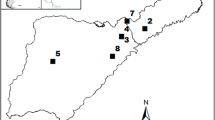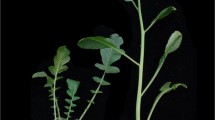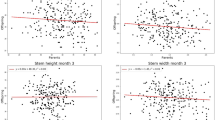Abstract
Heritability of flowering and leafing date of pistachio (Pistacia vera L.) were estimated based on half-sib family and parent-offspring regression analyses. Narrow sense heritabilities of flowering date ranged from 0.68 to 0.88 based on half-sib analyses and from 0.89 to 0.95 based on parent-offspring regression analyses. The narrow sense heritability of leafing date was 0.75 based on half-sib analyses and 0.60 from parent-offspring regression analysis. First leafing date was highly correlated with flowering date (r =0.59–0.78), suggesting that first leafing date could be used to select for flowering date in seedlings long before the onset off lowering.
Similar content being viewed by others
References
Becker, W.A., 1985. Manual of Quantitative Genetics. 4th edition. Academic Enterprises, Pullman, Wash.
Chao, C.T., D.E. Parfitt, L. Ferguson, C. Kallsen & J. Maranto, 1998. Breeding and genetics of pistachio: the California program. Acta Horticulturae 470: 152-161.
Chao, C.T., D.E. Parfitt & T.J. Michailides, 2001. Alternaria late blight (Alternaria alternata) resistance in pistachio (Pistachia vera) and selection for resistant genotypes. J Amer Soc Hort Sci 126: 481-485.
DeVries, D.P., 1967. Phenological stages in sweet cherry with regard to pre-selection. Euphytica 16: 177-182.
Dicenta, F., J.E. Garcia & E.A. Carbonell, 1993. Heritability of flowering, productivity and maturity in almond. J Hort Sci 68: 113-120.
Hansche, P.E., 1990. Heritability of spring bloom and fall leaf abscission dates in Prunus persica. HortScience 25: 1639-1641.
Hansche, P.E., V. Beres & R.M. Brooks, 1966. Heritability and genetic correlation in the sweet cherry. Proc Amer Soc Hort Sci 88: 173-183.
Hansche, P.E., V. Beres & H.I. Forde, 1972. Estimates of quantitative genetic properties of walnut and their implications for cultivar improvement. J Amer Soc Hort Sci 97: 279-285.
Kester, D.E., P. Raddi & R. Asay, 1977. Correlation of chilling requirements for germination, blooming and leafing within and among seedling populations of almond. J Amer Soc Hort Sci 102: 145-148.
McGranahan, G. & H.I. Forde, 1985. Relationship between clone age and selection trait expression in mature walnuts. J Amer Soc Hort Sci 110: 692-696.
Mehlenbacher, S.A. & A.M. Voordeckers, 1991. Relationship of flowering time, rate of seed germination, and time of leaf budbreak and usefulness in selecting for late-flowering apples. J Amer Soc Hort Sci 116: 565-568.
SAS Institute Inc., 1985. User's guide: Statistics. 5th ed. SAS Inst., Inc., Cary, NC.
Vargas, F.J., M. Romero, J. Clavé & I. Batlle, 1995. First results of vigor and leafing in pistachio progenies. Acta Horticulturae 419: 273-277.
Visser, T. & A.A. Schaap, 1967. Pre-selection for juvenile period, flowering and picking time in apple seedlings. Euphytica 16: 109-121.
Yao, Q. & S.A. Mehlenbacher, 2000. Heritability, variance components and correlation of morphological and phenological traits of hazelnut. Plant Breed 119: 369-381.
Author information
Authors and Affiliations
Rights and permissions
About this article
Cite this article
Chao, C., Parfitt, D., Ferguson, L. et al. Genetic analyses of phenological traits of pistachio (Pistacia vera L.). Euphytica 129, 345–349 (2003). https://doi.org/10.1023/A:1022206911350
Issue Date:
DOI: https://doi.org/10.1023/A:1022206911350




